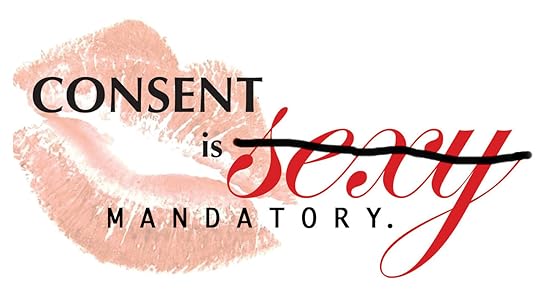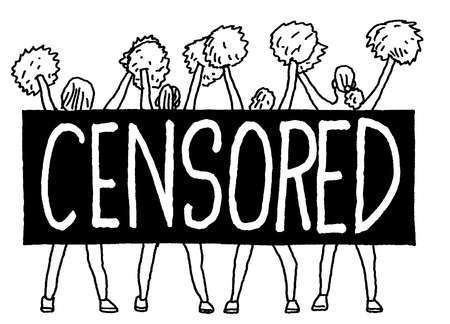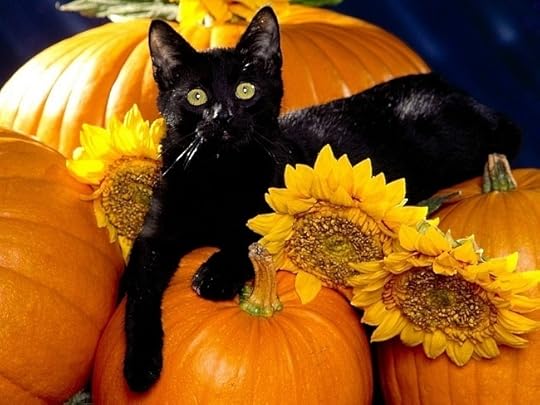S.B. Stewart-Laing's Blog, page 14
November 6, 2013
Can We Get Some Consent Over Here?
 Certain arms of the Internet Outrage Machine will cry 'rape apologist' over pretty much any discussion of sexual assault, be it genuinely destructive and victim-blaming or perfectly sensible safety advice*. This makes the lack of critiques of non-consensual sex in fantasy fiction even more surprising.
Certain arms of the Internet Outrage Machine will cry 'rape apologist' over pretty much any discussion of sexual assault, be it genuinely destructive and victim-blaming or perfectly sensible safety advice*. This makes the lack of critiques of non-consensual sex in fantasy fiction even more surprising.I'm actually not against portraying sexual assault in fantasy. After all, fiction-- particularly speculative fiction-- is a place where we can examine the best and worst of our society. In many cases, I think a supernatural element can allow us to step back and look more clearly at systemic problems. However, I do take issue with the vast amount of non-consensual sex, usually driven by love spells or supernatural sexy powers, which is given a free pass. This is enough of a thing that TVTropes has identified and cataloged several variants, all of them incredibly creepy.
Weirdly, the inhabitants of Fantasyland and Urban Fantasy City seem totally cool with this. Again, if the author establishes that there is an in-universe belief that you don't say 'no' to were-lions, or that you should count yourself lucky if a faerie decides to have their way with you, that's one thing, and potentially one fraught with plot-driving conflict. But eerily, there seems to be a group consensus among the citizens of Fantasyland that supernatural molesting is totally fine and a little bit titillating, especially if a hot person does it. I emphasise here that this isn't an in-story belief system which the author picks apart by showing us the consequences, but rather an in-story belief systems which is totally supported by the narrative as being peachy keen. This apparently unintentional horror is why Anita Blake makes me want to exorcist-vomit.
I'm picking on the Anita Blake series because it encapsulates the problem so perfectly. It runs on a series of nasty assumptions that infect the real world, namely:
If a woman is forcing someone to have sex, that's fine or even good;If the molester is hot, that makes it OK;If the victim experienced physical pleasure, then it's OK;Alternately, if drugs/love spell/superpowers made them do it, it's close enough to consent
Again, I'd be less appalled by this list if it wasn't a mirror of real-life attitudes which desperately need changing.
As I said, this isn't to say you shouldn't write a character with weaponised sexy powers or the like. Just show that there are consequences, and that those consequences are appropriately freaking creepy.
*Michael and I are both Amherst alumni, and both agree that 'hey, you'll be surrounded by drunk people you don't know, keep vigilant' is perfectly good advice for anyone who's going to be in a situation involving giant crowds of wound-up strangers. And 18-year-olds who think they're invincible and have never been away from home are the perfect demographic to be reminded of this fact.
Published on November 06, 2013 01:53
November 4, 2013
Zip It!
 'My Impression of Society: “SEXSEXSEXSEXSEXNUDITYFORNICATIONSEXSEX”'
'My Impression of Society: “SEXSEXSEXSEXSEXNUDITYFORNICATIONSEXSEX”'--Matt Walsh, on Superbowl ads
I don't think of myself as a prude. As a reader of urban fantasy, however, I've found myself increasingly put off by the nonstop boning. Not that I gave the matter much in-depth thought-- I consigned it to the 'I dislike filler that bogs down the plot' bin-- until my fiancee introduced me to the show Lost Girl.
For those of you who don't follow Canadian TV, Lost Girl is an urban fantasy series featuring a succubus named Bo as the main character. For obvious reasons, this means lots of sex. Given my annoyance This got me thinking-- why do I find Bo's adventures interesting, while Anita Blake makes me want to barf?
My conclusion is that it comes down to character development and consequences. By character development, I mean that the people Bo 'feeds' on are independent characters with their own backgrounds, needs, and agendas. They don't exist for her gratification, but rather intersect with her life as they run around doing their own things. Furthermore, they also use her to further their aims.
Consequences are a direct outgrowth of this character development. Specifically, because the other characters have their own lives (and are not simply satellites of the main character), Bo's romantic and sexual encounters quickly end up becoming entanglements. There are hidden agendas, hurt feelings, jealousy, and the constant fear that she'll lose control of her powers and drain someone to death. To complicate matters further, she must balance her personal feelings about her friends and sex partners with her supernatural needs.
By contrast, a lot of the gratuitous sex in urban fantasy books is lacks either. The main character's partners are unnaturally hot wish fulfillment puppets who never get jealous (except when the plot requires a Big Misunderstanding), never have their own lives (except as background angst), and essentially exist for the main character. The result is humping that makes no meaningful contribution to the plot or to our understanding of the characters.
Published on November 04, 2013 01:40
November 1, 2013
Mundane Solutions
'A miniaturized assassination robot small enough to slip through the bloodstream would cost how much? Millions? And it is delivered by dart? How's this for an idea: use a poison dart, and spend the surplus on school lunches.'--Roger Ebert
 One of the traps in writing speculative fiction is that of getting entirely fixated on the fantastic at the expense of the ordinary bits of the world. This is particularly prominent in urban fantasy, where the characters explicitly have access to the tools of the ordinary world (unless there's an in-universe reason for it to be otherwise). We assume the characters must solve the problem through magical means when completely convenient alternatives abound-- they're just not magical.
One of the traps in writing speculative fiction is that of getting entirely fixated on the fantastic at the expense of the ordinary bits of the world. This is particularly prominent in urban fantasy, where the characters explicitly have access to the tools of the ordinary world (unless there's an in-universe reason for it to be otherwise). We assume the characters must solve the problem through magical means when completely convenient alternatives abound-- they're just not magical.
I get particularly annoyed when this occurs in a world where supernatural creatures are trying to keep their existence a secret. If magic users or superpowered non-humans are 'out', I can see a plausible reason why ordinary methods might not work-- for example, a security guard might flat-out refuse to frisk a were-tiger for fear of having his head bitten off. But if your supernatural characters want to maintain a facade of normalcy, they have every reason to be cooperative, at least as much as the typical non-magic citizen. Personally, I'd love to see characters clever enough to really make use of their environment, and that includes using totally ordinary means to scupper each other's schemes. (Of particular note: our modern world is obsessed with security, and yet I have seen precisely zero urban fantasy characters mess up a someone's day by simply calling the cops/airport security/the local transit authority/customs to report suspiscious activity.)
Also, I find it jarring when a scheme totally includes obvious mundane hurdles (for example, the characters must get a bottle of healing potion or a pair of magical nailclippers past airport security) and then bypasses them with zero explanation. One solution is to have the obvious issue pop up and cause unexpected snags* for the characters to deal with on the fly. Another is to have them anticipate the problems and plan accordingly (or at least have an in-universe reason it's a non-issue).
*Given that I was stopped and searched by the TSA for carrying a bag of stick candy (which apparently looked like potential weapons on the scanner?), I can only imagine the fuss they'd throw over, say, a magic wand. Or what a sniffer dog would make of a werewolf...
 One of the traps in writing speculative fiction is that of getting entirely fixated on the fantastic at the expense of the ordinary bits of the world. This is particularly prominent in urban fantasy, where the characters explicitly have access to the tools of the ordinary world (unless there's an in-universe reason for it to be otherwise). We assume the characters must solve the problem through magical means when completely convenient alternatives abound-- they're just not magical.
One of the traps in writing speculative fiction is that of getting entirely fixated on the fantastic at the expense of the ordinary bits of the world. This is particularly prominent in urban fantasy, where the characters explicitly have access to the tools of the ordinary world (unless there's an in-universe reason for it to be otherwise). We assume the characters must solve the problem through magical means when completely convenient alternatives abound-- they're just not magical. I get particularly annoyed when this occurs in a world where supernatural creatures are trying to keep their existence a secret. If magic users or superpowered non-humans are 'out', I can see a plausible reason why ordinary methods might not work-- for example, a security guard might flat-out refuse to frisk a were-tiger for fear of having his head bitten off. But if your supernatural characters want to maintain a facade of normalcy, they have every reason to be cooperative, at least as much as the typical non-magic citizen. Personally, I'd love to see characters clever enough to really make use of their environment, and that includes using totally ordinary means to scupper each other's schemes. (Of particular note: our modern world is obsessed with security, and yet I have seen precisely zero urban fantasy characters mess up a someone's day by simply calling the cops/airport security/the local transit authority/customs to report suspiscious activity.)
Also, I find it jarring when a scheme totally includes obvious mundane hurdles (for example, the characters must get a bottle of healing potion or a pair of magical nailclippers past airport security) and then bypasses them with zero explanation. One solution is to have the obvious issue pop up and cause unexpected snags* for the characters to deal with on the fly. Another is to have them anticipate the problems and plan accordingly (or at least have an in-universe reason it's a non-issue).
*Given that I was stopped and searched by the TSA for carrying a bag of stick candy (which apparently looked like potential weapons on the scanner?), I can only imagine the fuss they'd throw over, say, a magic wand. Or what a sniffer dog would make of a werewolf...
Published on November 01, 2013 02:53
October 30, 2013
Pretty Monsters
 Happy Halloween, everyone!
Happy Halloween, everyone!Remember when vampires used to be scary? Or for that matter ghosts, demons, were-creatures, faeries, and anything else that might go bump in the night?
Twilight takes a lot of the heat for turning blood-sucking monsters into insipid, sparkly and thoroughly harmless props for teens to squee over, but it's only one of a plague of urban fantasy stories-- the True Blood books and TV show and the Anita Blake series being prominent offenders-- where supernatural creatures of all kinds are essentially stripped of any qualities besides supernatural sex appeal and maybe a few pretty powers.
On one level, my problem with this is that it's dull. You might as well write an ordinary romance, since you've stripped away a major potential conflict (even if you give it some lip service). But on a more fundamental level, removing the element of danger from the supernatural undermines what the fantasy genre is all about-- illuminating human nature by showing characters who confront things far more threatening than anything we would encounter in our everyday lives. It's about exploring the extremes by taking characters into situations where our carefully constructed social scripts are useless and our ethical frameworks are challenged.
Monsters are supposed to represent our fears, both about the outside world and the worst impulses in our own psyches. At the same time, many parts of western society are fixated on ignoring all things bad, even if that means sugar-coating them or brushing them aside for someone else to deal with. When I worked at a zoo, a surprising number of visitors would ask if they could pet the various large predators and seemed shocked at the idea that such an animal might actually hurt them. Part of me wonders if excising the scary bits has to do with the reduction of immediate physical danger and unpredictability in the lives of many people in the western world, particularly among the more privileged sub-groups over-represented among authors.
Perhaps it's time for the rampaging werewolf to retire in favour of something more subtle, and more in keeping with our modern fears and challenges. But whatever that monster is needs to retain an element of danger.
Published on October 30, 2013 02:32
September 30, 2013
Blog Holiday
The blog will be on pause for October, since I'm madly busy with travel, work, and excitement in my personal life-- not to mention finishing the latest book in the Forgotten Gods series. Posts will resume as usual after Halloween.
Please enjoy this video of a greyhound playing with a kitten.
Please enjoy this video of a greyhound playing with a kitten.
Published on September 30, 2013 09:43
September 25, 2013
Killing the Enemy
As much as I have a high tolerance for gross stuff (I was originally a marine biologist, after all!) I get a bit squeemish about fictional violence. Again, it's not the descriptions of the acts themselves, but the context and moral framework the violence is given in the storyline.
Recently, I have been watching Legend of the Seeker, a TV adaptation of Goodkind's Sword of Truth series. It is what one of my aunts calls 'bubblegum for the mind'-- lots of good-looking people running around with swords, fighting the cartoonish forces of evil with magical explosions. In other words, an excellent distraction to have on in the background while doing chores. There is a pretty obvious line drawn between Good and Evil, with one exception. The forces of Good are crazy violent, and seem to solve most of their problems by hacking enemies to bits every five minutes. For a character who is supposed to be on a mission to spread peace and justice, this presents an inherent moral problem, particularly since the main objection to the villain is that he uses outrageously violent tactics to squash any opposition.
The violence double-standard crops up a lot in high fantasy. One way of dealing with it is to introduce an enemy that is 'always chaotic evil', as Tolkien did with Sauron's army of orcs. In many genres-- the traditional zombie flick being a notable exception, since by definition one's opponents are already dead-- this solves the violence problem while creating another thorny issue: can an entire sentient species be 100% evil?
The other approach is to bluntly engage the double standard in the story itself. Show both sides using the same hypocritical rhetoric to condemn the tactics of their opponents while crowing triumphantly when their side commits similar acts of brutality. It's much more difficult to do this than to create an 'always chaotic evil' video game enemy, but it lends realism and moral nuance to your story.
Recently, I have been watching Legend of the Seeker, a TV adaptation of Goodkind's Sword of Truth series. It is what one of my aunts calls 'bubblegum for the mind'-- lots of good-looking people running around with swords, fighting the cartoonish forces of evil with magical explosions. In other words, an excellent distraction to have on in the background while doing chores. There is a pretty obvious line drawn between Good and Evil, with one exception. The forces of Good are crazy violent, and seem to solve most of their problems by hacking enemies to bits every five minutes. For a character who is supposed to be on a mission to spread peace and justice, this presents an inherent moral problem, particularly since the main objection to the villain is that he uses outrageously violent tactics to squash any opposition.
The violence double-standard crops up a lot in high fantasy. One way of dealing with it is to introduce an enemy that is 'always chaotic evil', as Tolkien did with Sauron's army of orcs. In many genres-- the traditional zombie flick being a notable exception, since by definition one's opponents are already dead-- this solves the violence problem while creating another thorny issue: can an entire sentient species be 100% evil?
The other approach is to bluntly engage the double standard in the story itself. Show both sides using the same hypocritical rhetoric to condemn the tactics of their opponents while crowing triumphantly when their side commits similar acts of brutality. It's much more difficult to do this than to create an 'always chaotic evil' video game enemy, but it lends realism and moral nuance to your story.
Published on September 25, 2013 02:58
September 20, 2013
The Past is the Past
'I am very conscious that you can’t condemn people of an earlier era by the standards of ours. Just as we don’t look back at the 18th and 19th centuries and condemn people for racism in the same way as we would condemn a modern person for racism, I look back a few decades to my childhood and see things like caning, like mild pedophilia, and can’t find it in me to condemn it by the same standards as I or anyone would today.
--Richard DawkinsOne of the big problems of writing about history is the matter of how to present people who were operating under a different ethical framework. On one hand, it's tempting to sidestep the problem by giving all your characters an inexplicablely modern perspective. It's also tempting to do as Dawkins suggests and pretend that just because something was considered acceptable in a particular time and place, it was fine by all parties involved, and didn't cause the sort of problems that it would in the modern day.
The first approach is less fraught with discomfort. We get to stay in our comfort zone and enjoy the flavour of the historical setting in an uncomplicated way. Some genres, such as romance, which run on wish-fulfillment, may actually require this tactic to some degree. The dark side, however, is that we're being implicitly asked to dismiss the worst parts of the past as the work of a few evil 'bad apples', rather than systemic problems which could only be slowly dismantled by large-scale social movements.
The second is an entirely different matter. There is a big difference between placing ideas and actions in context, and trying to pretend they didn't matter or didn't cause harm because it was socially acceptable-- at least among the perpetrators. At the same time, it seems wrong to condemn as monsters the small number of people who committed great wrongs under the sincere (though totally misguided) desire to do good.
My usual approach is to emphasise that dichotomy, showing both the intention, and how that intention went horribly wrong, or the damage from some widely accepted belief or behaviour in a setting where people merrily carry on, oblivious to the havoc they cause. It's not an approach that lends itself to tidy answers, or emotional comfort, but I think it's the best way to show how the complexity of the past has created the present.
Published on September 20, 2013 01:16
September 18, 2013
The Voyeur Threshold
Writers, by nature, have to be a bit sadistic. After all, we have to purposely place our characters in situations designed to cause maximum conflict. At the same time, I think there is a line where 'describing the conflict' becomes an exercise in virtual rubbernecking. Honestly, it can be a bit creepy.
Where this line falls is pretty subjective, but most people seem to have an 'I know it when I see it' sense of when highly visceral description becomes uncomfortable. Some of this depends on the author's delivery, the tone of the story, and the expectations of the genre, as well as the reader's personal squick threshold. For example, certain subgenres of horror come with the expectation of vividly described blood and gore; confessional memoirs and 'misery lit' come with the expectation of detailed accounts of psychological trauma or abuse or drug abuse. Arguably, some genres require the reader to have a perverse 'watching the train wreck' fascination with awful things happening to the characters.
At the same time, problems start to occur when these tropes-- particularly the ones from misery lit-- begin leaking into other genres. For some reason, fantasy seems to be a magnet for both the overblown descriptions of abuse and torture and massive sprays of battle gore. This is significantly less creepy when the author is given to detailed descriptions of everything. The creepy factor shows up-- in my opinion-- when the abuse or torture or infected wounds get descriptions that are far more detailed than other parts of the story, hinting at some level of authorial glee.
I'd also like to point out that excessive descriptions of violence (or sex, or landscapes, or angst) quickly desensitize the reader to the point of skipping over those passages. Often, it's more effective to keep things toned down and then hit the reader with a single, evocative line.
Where this line falls is pretty subjective, but most people seem to have an 'I know it when I see it' sense of when highly visceral description becomes uncomfortable. Some of this depends on the author's delivery, the tone of the story, and the expectations of the genre, as well as the reader's personal squick threshold. For example, certain subgenres of horror come with the expectation of vividly described blood and gore; confessional memoirs and 'misery lit' come with the expectation of detailed accounts of psychological trauma or abuse or drug abuse. Arguably, some genres require the reader to have a perverse 'watching the train wreck' fascination with awful things happening to the characters.
At the same time, problems start to occur when these tropes-- particularly the ones from misery lit-- begin leaking into other genres. For some reason, fantasy seems to be a magnet for both the overblown descriptions of abuse and torture and massive sprays of battle gore. This is significantly less creepy when the author is given to detailed descriptions of everything. The creepy factor shows up-- in my opinion-- when the abuse or torture or infected wounds get descriptions that are far more detailed than other parts of the story, hinting at some level of authorial glee.
I'd also like to point out that excessive descriptions of violence (or sex, or landscapes, or angst) quickly desensitize the reader to the point of skipping over those passages. Often, it's more effective to keep things toned down and then hit the reader with a single, evocative line.
Published on September 18, 2013 02:35
September 16, 2013
Cultural Myopia
 All of us are a bit narcissistic. Simply put, it's human nature to assume that we are not only correct, but that other people are just like us (or could be just like us, with a little helpful prodding). On a broader level, sociologists call this ethnocentrism--the tendency to use our cultural metrics to evaluate everyone else, regardless of whether or not it's appropriate. To make matters more difficult, we often assimilate these values and mannerisms subconsciously, so we're not even fully aware of the signals we're sending and reading.
All of us are a bit narcissistic. Simply put, it's human nature to assume that we are not only correct, but that other people are just like us (or could be just like us, with a little helpful prodding). On a broader level, sociologists call this ethnocentrism--the tendency to use our cultural metrics to evaluate everyone else, regardless of whether or not it's appropriate. To make matters more difficult, we often assimilate these values and mannerisms subconsciously, so we're not even fully aware of the signals we're sending and reading.The first and most obvious trap is to assume that we are right and everyone else is Doing It Wrong. This seems stupidly obvious, but I know I've done it in real life, as has everyone I know, because many times we believe our interpretations of various situations to be universal. This is something to watch out for big-time when reading primary sources.
One manifestation of this is characters who speak about the culture they have spent their entire life immerse in as though they were continuously surprised at how it is different from modern 'Western' culture (in How Not to Write a Novel, Mittlemark and Newman call this 'Hello, I Am The Medieval Knight'). This is jarring, especially in settings where the character has no real contact with other cultures, and thus no real reason to question their own way of doing things. The solution is the inverse of what you're doing-- know what their fundamental beliefs would be, and have the character treat these as facts so obvious as to not be stated, even as those beliefs guide the character's actions.
The other manifestation is the clone world, where every character shares the author's cultural views, regardless of whether it's appropriate to the setting. If a social conceit has no reason to develop in a particular setting, it really shouldn't wander in there. As I noted, the other, more sinister, offshoot of this is the world where all the good guys share the author's cultural values (usually in defiance of setting) and the bad guys are the ones who don't.
Because our cultural assumptions are so ingrained, it's often hard to identify what they are until they are directly challenged by something in our environment. My favourite way to make myself aware is to go on a 'question everything' kick, where I analyse everything I do for a day and think about all the attached cultural reasons for my choices-- for example, what is a 'breakfast food' and why would I choose, say, waffles, over perfectly delicious leftover noodles as an acceptable breakfast item? Even if you're not writing a character in a radically different setting than your own environment, it's a good exercise in self-awareness.
Published on September 16, 2013 03:49
September 13, 2013
These Are My People
The problem with having characters from under-represented groups is that this person becomes their group's ambassador to everyone. In principle, there's nothing wrong with this, particularly if it introduces the reader to a interesting culture, viewpoint, or experience that is a distinct minority in the general population. In practice, this has a tendency to go rather badly wrong.
The first fail is the token character from a group which is in no way an actual minority. The most persistent example is the absence of women in settings where women should be represented as proportional numbers to the general population-- in other words, they should comprise about half the cast. Racial examples are also quite common in historical fiction, and that's even when you get past the ubiquity of the Heterosexual White-Anglo Lead. For example, Pirates of the Caribbean was overrrun by white actors, even though the setting, at that time period, was 90% Afro-Caribbean and mestizo (and remains that way today).
The second fail happens when a character who is genuinely from a minority group is the token minority, and they are a walking stereotype-- the sassy gay friend, the wise Native American who helps the protagonists, etc. Worse, the is a villain and their identity is the core reason for their villainy. Not in the sense that their motive and identity are linked, but in the sense that people like them are shown as being inherently bad. One nasty recent example is the main antagonist of Diane Gabadon's Outlander series, an Evil Bisexual whose entire motive, backstory and distinguishing character traits are that he likes people of both genders and sticking his dick where it's not wanted. Needless to say, it's not okay (even if, like Gabadon, you allegedly 'have gay friends') to imply that an entire group is Always Chaotic Evil by way of the representative specimen. At least here there's an easy fix-- write a good villain.
The first fail is the token character from a group which is in no way an actual minority. The most persistent example is the absence of women in settings where women should be represented as proportional numbers to the general population-- in other words, they should comprise about half the cast. Racial examples are also quite common in historical fiction, and that's even when you get past the ubiquity of the Heterosexual White-Anglo Lead. For example, Pirates of the Caribbean was overrrun by white actors, even though the setting, at that time period, was 90% Afro-Caribbean and mestizo (and remains that way today).
The second fail happens when a character who is genuinely from a minority group is the token minority, and they are a walking stereotype-- the sassy gay friend, the wise Native American who helps the protagonists, etc. Worse, the is a villain and their identity is the core reason for their villainy. Not in the sense that their motive and identity are linked, but in the sense that people like them are shown as being inherently bad. One nasty recent example is the main antagonist of Diane Gabadon's Outlander series, an Evil Bisexual whose entire motive, backstory and distinguishing character traits are that he likes people of both genders and sticking his dick where it's not wanted. Needless to say, it's not okay (even if, like Gabadon, you allegedly 'have gay friends') to imply that an entire group is Always Chaotic Evil by way of the representative specimen. At least here there's an easy fix-- write a good villain.
Published on September 13, 2013 01:43



